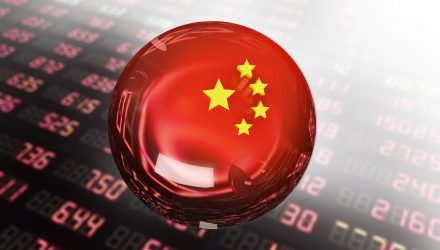Chinese stocks are experiencing a rebound, with the Shanghai and Shenzhen Stock Exchanges both closing in the positives in sharp contrast to U.S. markets. It is part of a larger trend of monetary easing that China is embarking on while the U.S. central banks tighten aggressively.
Expectations for tomorrow are that the People’s Bank of China will lower the medium-term Lending Facility by 10 basis points, reported KraneShares in the China Last Night blog, and this is one more policy in a string of quantitative easing that the Chinese central bank has enacted this year. Earlier in the year the PBOC reduced the reserve ratio requirements by 0.25%, allowing banks to lend more money, and lowered loan prime rates for mortgages.
Tomorrow also brings reports for retail sales as well as industrial production, and the anticipation is that these reports will come in positively.
“Markets are expecting decent May figures, which may allow for 1 & 5 Year Loan Price Rates to be cut again over the weekend,” KraneShares wrote.
An environment of quantitative easing in China could lead to short-term growth opportunities, though China does face challenges looking ahead. Premier Li Keqiang held a meeting in May with officials from across the country, encouraging the use of all resources necessary to help stabilize the Chinese economy, and admitted that China may fall short of its 5.5% GDP goal in 2022. However, even with challenges, supportive government policies adding liquidity to the economy could provide several opportunities for Chinese companies.
Risk in China and Foreign Investor Interest
Investing in China currently carries a level of risk that has had many foreign investors hands-off in the last year. With top officials signaling that the regulatory cycle is drawing to a close, regulatory risk is seen to be decreasing for investors, however, and foreign participation in Chinese markets is beginning to grow again.
Overnight trading saw foreign investors buying $585 million in mainland stocks. The Shanghai Stock Exchange closed up 1.02% while the Shenzhen Stock Exchange was up 0.19% at the close. In contrast, the S&P 500 closed down 3.8% in trading Monday, and the Nasdaq Composite closed at a 4.7% loss.
China’s zero-tolerance COVID-19 policy also carries a level of risk that advisors and investors should be aware of, as lockdowns have seen much of the economic activity slow drastically in major areas such as Shanghai and key ports that have impacted the global supply chain. It’s one of the primary drivers of the reduction in GDP estimates as pandemic lockdowns continue to incrementally stall the Chinese economy.
On the U.S. side, the threat of delisting of Chinese companies from U.S. exchanges has had an impact on valuations and perceived risk as China and the U.S. work to find an agreement that both countries can accept regarding audit inspections.
Investment Opportunity With KBA
For investors who are looking for exposure to China but wish to sidestep delisting risk, investing in China’s A-shares market could be one option to consider. The A-shares market has historically only been available to Chinese residents and consists of mainland Chinese companies that trade on the two local Chinese exchanges: the Shenzhen Stock Exchange and the Shanghai Stock Exchange.
The KraneShares Bosera MSCI China A Share ETF (KBA) invests in Chinese A-shares — specifically those from the MSCI China A 50 Connect Index. This fund seeks to capture 50 large-cap companies that have the most liquidity and are listed on the Stock Connect while also offering risk management through the futures contracts for eligible A-shares listed on the Stock Connect. The index utilizes a balanced sector weight methodology to give exposure to the breadth of the Chinese economy.
Holdings in KBA include Contemporary Amperex Technology, a Chinese battery manufacturer, at 8.50%; Kweichow Moutai, a major alcohol producer in China, at 7.96%; and Longi Green Energy Technology Co., a solar energy technology company, at 6.38%.
KBA carries an expense ratio of 0.56% with fee waivers that expire on August 1, 2022.
For more news, information, and strategy, visit the China Insights Channel.

